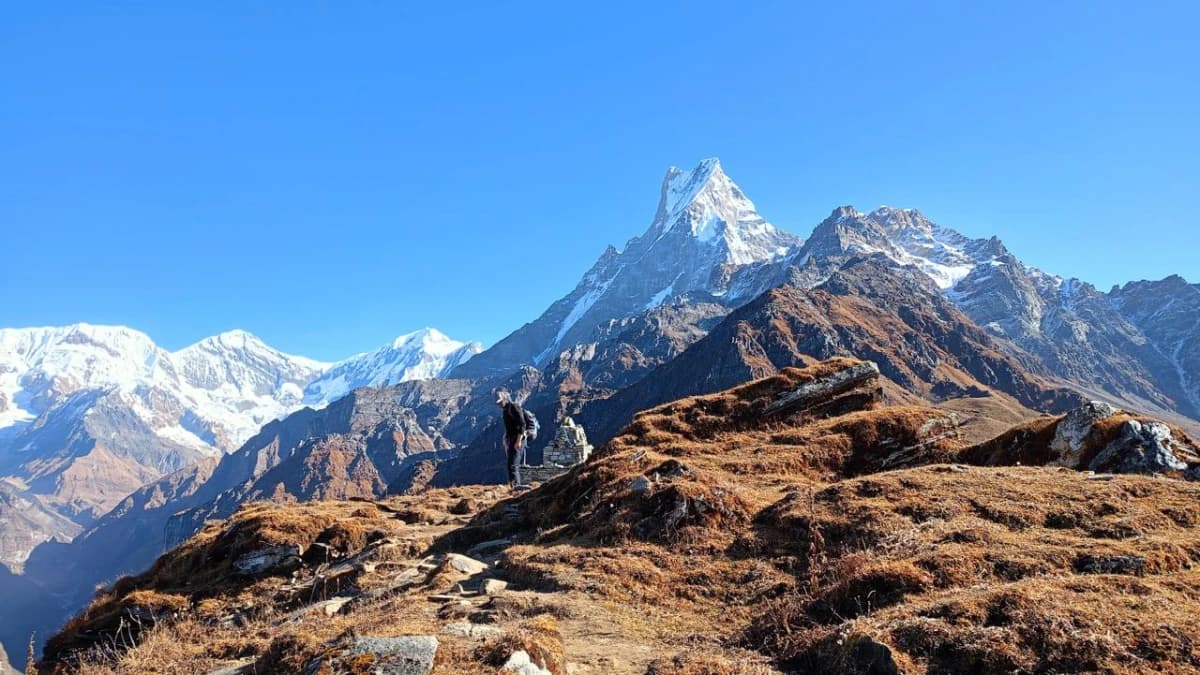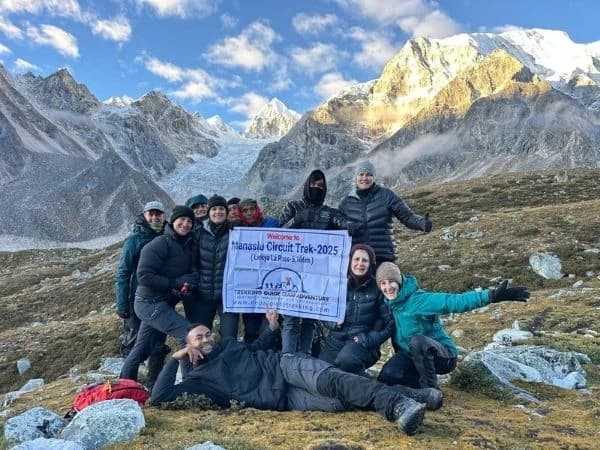Mardi Himal Trek is the best trek for you if you are looking for relatively shorter alternative to the famous Annapurna Base Camp Trek. It is also recommended for you if you prefer quiet and secluded trek. It is the emerging trek in Annapurna region, which takes you through the views of mesmerizing Machhapuchhre (also known as fishtail), south Annapurna and Himchuli. On top of that you have to pass through dense forest and ridges which gives you sense of peace and close to the nature.
The Mardi Himal Trek can be the ideal choice for you if you are searching for a moderate hike that offers beautiful mountain views, less crowds, and a unique mix of cultures and nature.
1. Overview of Mardi Himal Trek
What is Mardi Himal Trek?
The Annapurna region's Mardi Himal Trek is a comparatively short trip that completes at Mardi Himal Base Camp, which is situated directly below Machapuchare. It is a great option for hikers who anticipate to see some of the Himalayas' tallest peaks up close without having to deal with crowds.
Where is Mardi Himal Trek?
The trek begins at the the start point in Kande or Phedi, which is a short drive from Pokhara, and continues through the Annapurna Conservation Area. Mardi Himal Base Camp, located at a height of approximately 4,500 meters above sea level, is the ultimate destination of this trek.
How long does the Mardi Himal Trek take?
It solely depends on the factors like your starting point, your pace, chosen itinerary- rest days, acclimatization days and so on. Based on these, it normally takes 7-9 days if time to travel from Kathmandu to Pokhara and vice versa is taken in consideration.
2. Why Choose the Mardi Himal Trek?
Relatively Shorter
This trip is perfect for those with a tight schedule because it can be done in less than a week.
Mesmerizing Mountain Views
Without ascending over 5,000 meters, you can enjoy mesmerizing views of Hiunchuli, Machapuchare, Annapurna South, and Mardi Himal.

Fewer Crowds
In comparison to the famous treks like Everest Base Camp Trek and Annapurna Base Camp Trek, Mardi Himal trek trail is relatively emerging one and not as crowded. This allows you to experience peaceful trekking.
Accessible from Pokhara
The start point of Mardi Himal Trek is close to Pokhara, which avoids the need for long bus or jeep rides into remote trails.
3. Local Culture and People
Along the trek, you will also encounter the beautiful local villages where Magar and Gurung communities reside. There you will be able to find local hospitality, local organic farming, and teahouses run by locals though the trip is more nature-focused. This provides you a chance to interact with Nepali culture in a local environment.
4. Trek Difficulty and Fitness Level Required
Physical Difficulty
Though Mardi Himal Trek includes gradual climbs through dense forest, hike in ridge, it is identified as having moderate difficulty level.
Altitude Profile
At 4,500 meters, Mardi Himal Base Camp is the highest point. Trekkers should however ascend slowly and drink enough of water even though altitude sickness is less likely here than on higher climbs.
Who Can Do This Trek?
This hike is suitable for anyone with some trekking experience and a reasonable level of fitness. No prior knowledge of mountaineering is necessary.

5. Mardi Himal Trek Itinerary (Day-wise Breakdown)
Day 1: Pokhara to Kande – Trek to Forest Camp (2,540 m)
Start your trip by taking a 1.5-hour drive from Pokhara to Kande. The route climbs from Kande to Forest Camp (2,540 m) along forest trails and terraced fields. After passing villages in the area, you'll enter thick oak and rhododendron woods.
Day 2: Forest Camp to Low Camp (2,970 m)
You keep walking through dense woods. The trail progressively rises, with random nature then clearings providing views of Machapuchare. The air cools and becomes more alpine.
Day 3: Low Camp to High Camp (3,580 m)
On the third day the trek follows routes with ridges allowing you to experience the views of the valley below and Annapurna peaks ahead. As you continue, it will take you through thinner forest and finally reaching the High Camp in the afternoon.
Day 4: High Camp to Mardi Himal Base Camp (4,500 m) and Return
To get to the base camp, start earlier. With up-close views of Machapuchare and Mardi Himal, the trek is more challenging but satisfying. After some time in base camp, head back to High Camp.
Day 5: High Camp to Siding Village
Take an alternative route down through the forest, arriving at the peaceful farming village called Siding. A broader cultural look at rural Nepali life is thus offered.
Day 6: Siding to Pokhara (Drive)
In the morning after breakfast, you will drive back to Pokhara which will take 3-4 hours. Afterward you can enjoy your free time at the lake side
6. Best Time to Trek Mardi Himal

Autumn (September to November)
This is the most popular period because of the clear skies, steady weather, and good visibility. The well-defined, dry trails are perfect for travellers of all skill levels. Because of a significant number of trekkers, expect crowded teahouses and mild daytime conditions.
Spring (March to May)
The trail is colourful and offers fantastic views of the mountains while rhododendrons bloom.
It's a pleasant time of year to hike because of the moderate temperatures.
Particularly between Forest Camp and Low Camp, the forests are at their most colourful times.
Winter (December to February)
At higher elevations, there is snow and cold weather, but there are fewer hikers and clear views of the mountains. Perfect for people who love solitary; appropriate equipment is necessary for safety and warmth. While some higher teahouses may be closed because of snow, lower camps are still open.
Monsoon (June to August)
This time of year, is less favourable to hiking because of the heavy rain, leeches, and overcast skies. Particularly in forest areas, trails may be slippery, also vulnerable to landslides.
Nevertheless, the terrain is beautiful and lush and green and hikers who go during short droughts might find peaceful trails.
7. Weather and Temperature by Season
| Season | Temperature during the day | Temperature at night | Note |
|---|---|---|---|
| Spring | 10°C-20°C | 0°C to 5°C | Clear mornings, blooming trails |
| Autumn | 12°C-22°C | 2°C to 7°C | Best visibility |
| Winter | 5°C-15°C | -5°C to 0°C | Cold but less crowded |
| Monsoon | 15°C-25°C | 10°C to 15°C | Rainy, slippery trails |
8. Accommodation and Food
Accommodation

Every night you will stay in the teahouses which is available at overnight stops. These teahouses have basic facility yet comfortable and warm. Usually, you will need to share room and also bathroom with others as most of them have twin sharing rooms available.
Food
Rice, lentils, noodles, soup, pasta, and vegetables are commonly available options for meal whereas breakfast options are eggs, pancakes, and oatmeal and so on.
Charging and Internet
Most teahouses offer charging at an extra cost. Wi-Fi was limited before but is available now with extra cost around 500 nepali rupees.
9. Permits and Regulations
Required Permits:
-
ACAP (Annapurna Conservation Area Permit)
-
TIMS (Trekkers' Information Management System) Card
All of the required permits and logistics are handled for you during our guided Mardi Himal Trek with Trekking Guide Team Adventure. We make sure everything is set up properly so you can solely focus on savouring the journey, whether you're beginning from Kathmandu or Pokhara.
10. Optional Trek Extensions
- Combine with Annapurna Base Camp
- Visit Poon Hill or Australian Camp
- Stay in cultural villages like Landruk or Ghandruk
11. Mardi Himal vs Other Popular Treks
| Trek | Duration | Maximum Altitude | Level of Crowd | Highlights |
|---|---|---|---|---|
| Mardi Himal | 5-7 days | 4,500 m | Low | Forest + ridge views |
| Annapurna Base Camp | 7-12 days | 4,130 m | Medium | Valley + glacier |
| Poon Hill | 3-5 days | 3,210 m | High | Sunrise viewpoint |
| Everest Base Camp | 12-14 days | 5,364 m | High | Glacier |
Conclusion
Trekkers seeking a peaceful adventure in the Annapurna region might consider the Mardi Himal Trek. It combines a balance between natural beauty, cultural interactions, and a reasonable degree of difficulty. Mardi Himal offers a fulfilling adventure without requiring several weeks off, regardless of your level of experience. This is true whether you're a novice hoping to explore the Himalayas or an experienced hiker searching for a more tranquil track.
To improve your experience, plan ahead, pick the ideal time of year, and think about hiring a local guide or porter if you want to explore this hidden gem.






